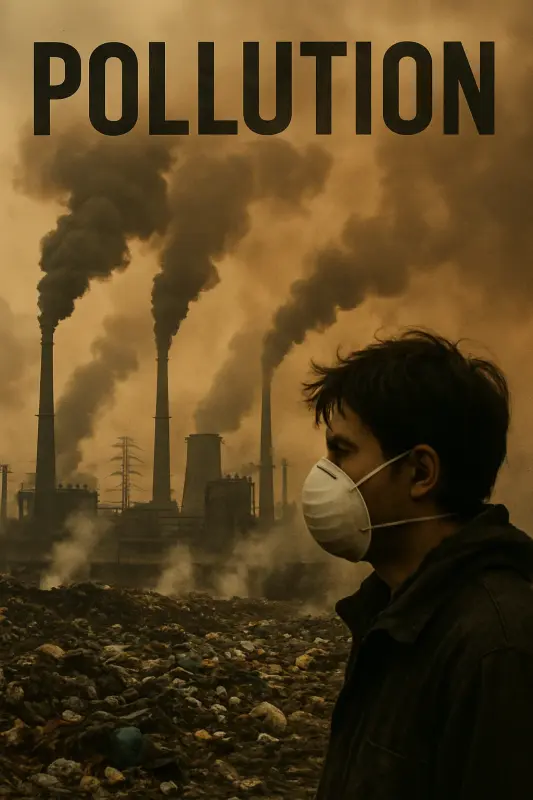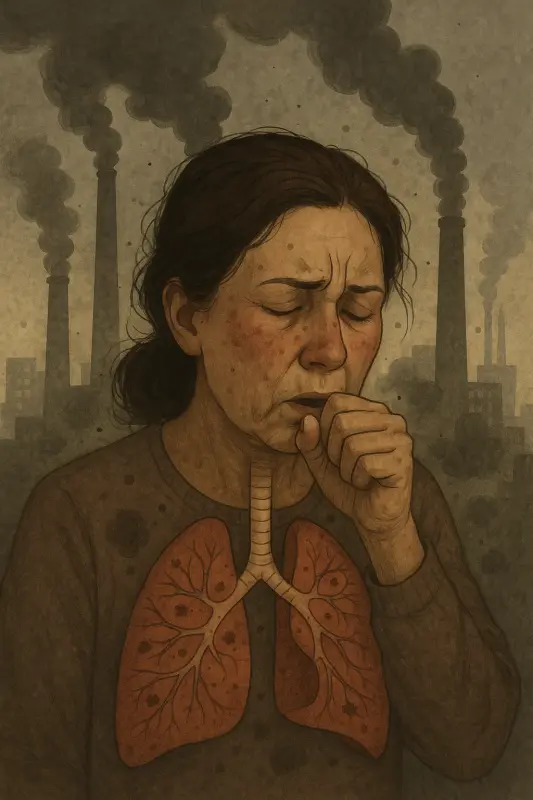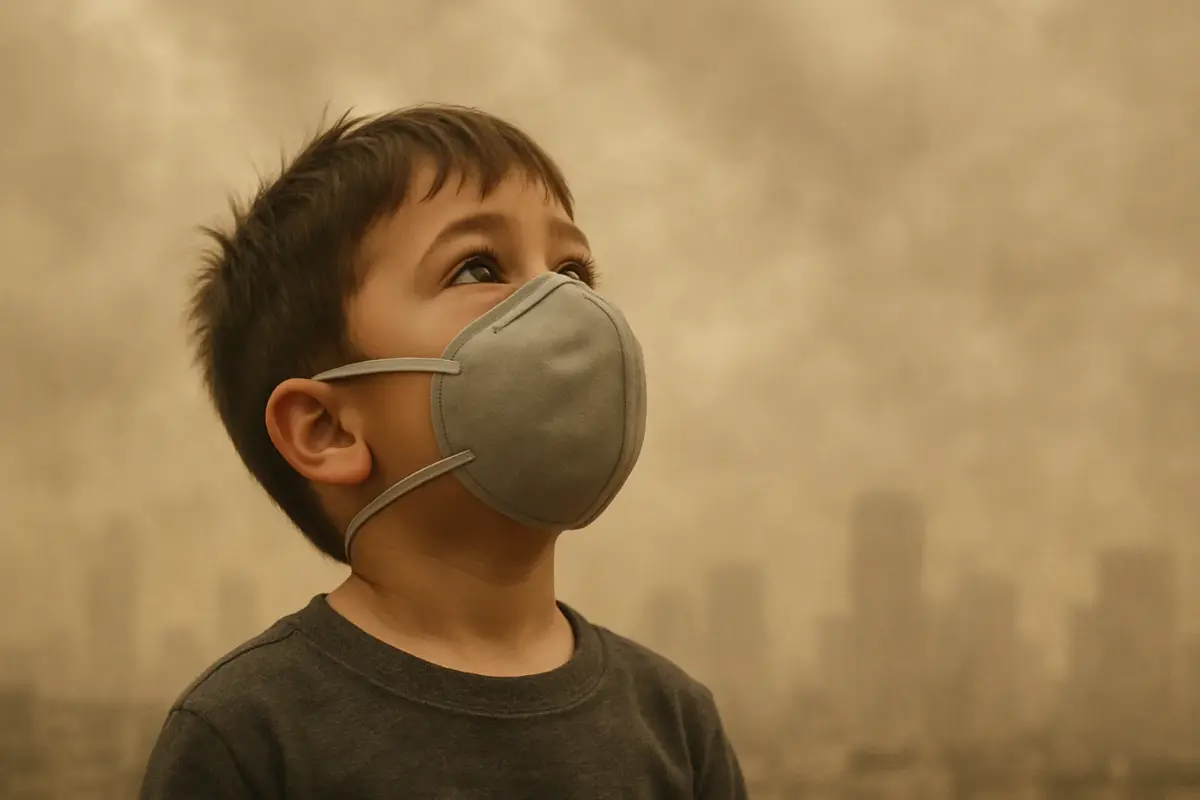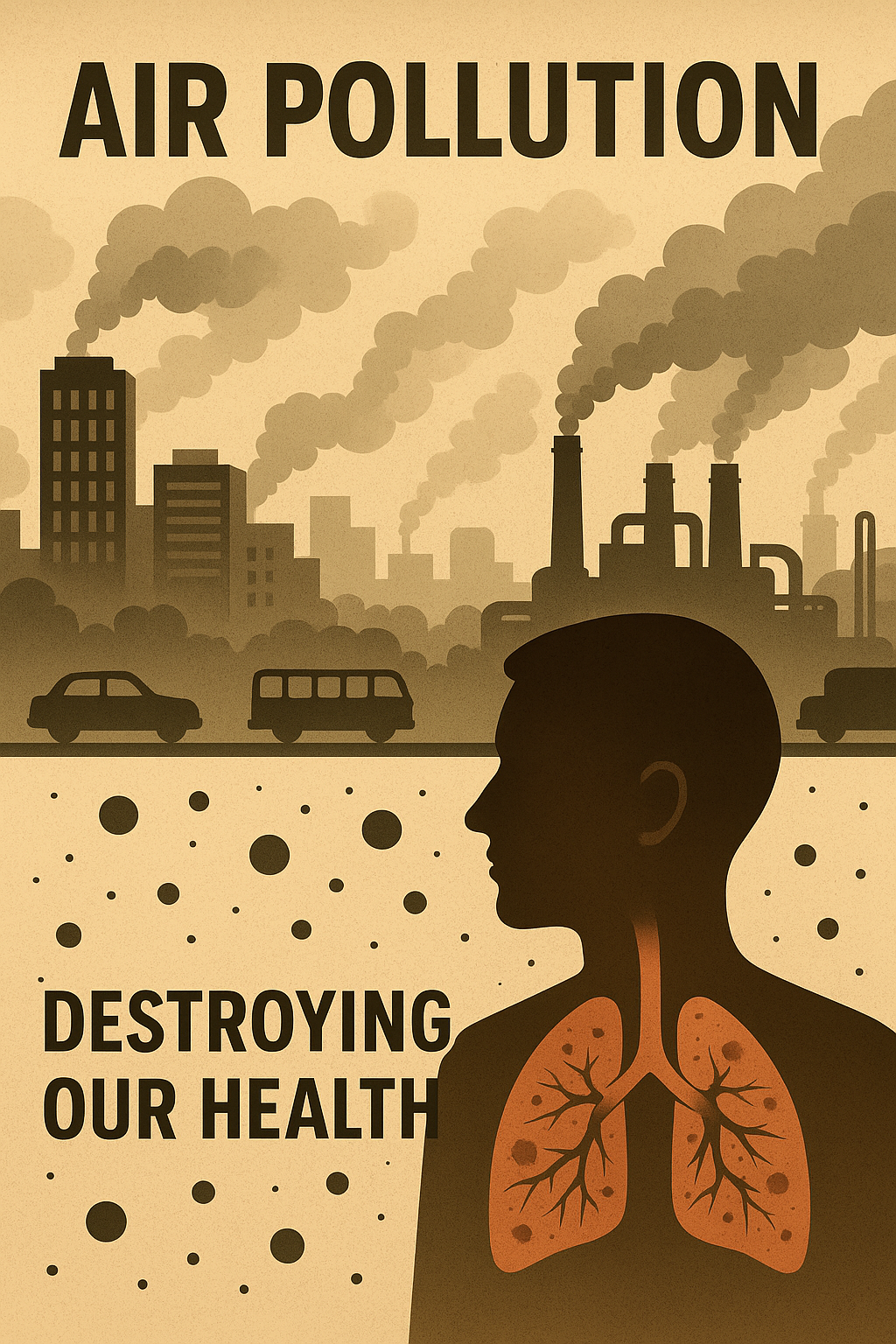Subtotal ₹0.00
Table of Contents
ToggleHow Air Pollution is Destroying Our Health: Shocking Effects Revealed
Introduction
Air pollution and health are deeply intertwined. As invisible as it may be, air pollution is a major contributor to millions of preventable deaths globally. From lungs to brain, this silent killer is damaging vital organs every day. According to the WHO, 99% of people breathe unsafe air. Here’s how it’s affecting you—and what to do about it.
As urbanization, industrialization, and vehicular traffic increase globally, so do the dangers of polluted air. It is vital for individuals, communities, and governments to understand the risks and act decisively to curb this health crisis.What is Air Pollution?
Air pollution refers to the presence of harmful substances in the atmosphere. These substances can be either natural or human-made and are harmful to both human health and the environment. Common air pollutants include:- Particulate Matter (PM2.5 and PM10): Tiny particles that can penetrate deep into the lungs.
- Nitrogen Dioxide (NO2): Emitted from vehicle exhaust and industrial activities.
- Sulfur Dioxide (SO2): Produced from burning fossil fuels like coal and oil.
- Carbon Monoxide (CO): A colorless, odorless gas from car engines and heating appliances.
- Ozone (O3): Ground-level ozone formed by chemical reactions between NOx and VOCs in sunlight.

How Air Pollution Affects the Human Body
Airborne pollutants enter the human body primarily through inhalation. Once inhaled, these particles and gases can travel deep into the lungs and, in many cases, enter the bloodstream. This process can trigger a range of biological reactions that adversely affect organs and systems throughout the body.Short-term Effects:
- Eye, nose, and throat irritation
- Coughing and shortness of breath
- Exacerbation of asthma and allergies
Long-term Effects:
- Chronic respiratory diseases like COPD
- Cardiovascular diseases
- Increased risk of neurological disorders and cancer
Air Pollution and Health: Respiratory Risks
One of the most immediate and severe impacts of air pollution is on the respiratory system. Prolonged exposure to airborne pollutants can damage lung tissues and significantly impair breathing functions.Asthma
Air pollutants such as ozone and particulate matter are well-known asthma triggers. They can provoke asthma attacks and worsen symptoms in both adults and children. Studies have shown that people living in highly polluted areas experience more frequent hospital visits and need higher doses of medication to manage symptoms.Chronic Obstructive Pulmonary Disease (COPD)
According to the American Lung Association, long-term exposure to fine particulate matter increases the risk of developing COPD. Inflammation caused by pollutants narrows the airways and reduces airflow, which can be debilitating and life-threatening.Bronchitis
Air pollution, especially sulfur dioxide and nitrogen dioxide, is a significant contributor to both acute and chronic bronchitis. These pollutants irritate the bronchial tubes, causing persistent coughing, mucus production, and chest discomfort.
Cardiovascular Impacts
Air pollution doesn’t just affect your lungs—it also endangers your heart. Fine particles can enter the bloodstream through the lungs, leading to inflammation and damage to blood vessels.- Heart Attacks: Air pollution can trigger heart attacks by increasing plaque buildup in arteries and causing sudden blood pressure spikes.
- Strokes: Exposure to PM2.5 has been linked with higher stroke risk, especially in elderly individuals and those with pre-existing heart conditions.
- Hypertension: Long-term pollution exposure can lead to consistently elevated blood pressure, increasing the risk of heart disease.
Air Pollution and Children’s Health
Children are among the most vulnerable populations when it comes to air pollution. Their organs are still developing, and they breathe more air per unit of body weight compared to adults, making them particularly susceptible to harm.Impaired Lung Development
Studies show that children exposed to polluted air have significantly reduced lung function and are more likely to suffer from chronic respiratory diseases later in life.Increased Asthma Risk
Living in high-traffic or industrial areas increases the likelihood of childhood asthma. According to UNICEF, 1 in 10 children worldwide is diagnosed with asthma—many cases exacerbated or caused by air pollution.Cognitive and Behavioral Effects
Air pollution has been linked to cognitive development issues, including reduced IQ and memory function. Exposure to NO2 and PM2.5 can also contribute to ADHD and other behavioral disorders.
Elderly and Vulnerable Populations
Older adults, individuals with pre-existing conditions, and low-income communities are particularly vulnerable to the adverse effects of air pollution. With weakened immune systems and often limited access to healthcare, the elderly face a higher risk of pollution-related complications.
- Exacerbation of Chronic Diseases: Conditions like COPD, heart disease, and diabetes worsen with poor air quality.
- Increased Hospital Admissions: Hospitals report higher admission rates for respiratory and cardiac issues during high pollution periods, especially among seniors.
- Mortality Risk: The National Institutes of Health (NIH) notes that long-term exposure significantly raises mortality risks among people over 65.
Community planning and targeted interventions are essential to protect these vulnerable groups from long-term exposure and related health deterioration.
Mental Health and Cognitive Decline
While most health conversations about air pollution center on lungs and heart, emerging evidence highlights its effect on the brain. Pollutants such as PM2.5 and nitrogen dioxide can cross the blood-brain barrier and induce neuroinflammation.
Depression and Anxiety
Air pollution is associated with increased risks of depression and anxiety disorders. A study published in Nature found that individuals in highly polluted areas showed significantly higher rates of depressive symptoms.
Alzheimer’s and Dementia
Chronic exposure to fine particles accelerates cognitive decline and increases the risk of neurodegenerative diseases such as Alzheimer’s. Toxic particles may lead to the accumulation of beta-amyloid plaques, a hallmark of Alzheimer’s disease.
Children’s Cognitive Development
In young people, pollution affects brain development, resulting in lower academic performance and behavioral issues. This neurological impact can have long-term socioeconomic consequences for affected communities.
Cancer Risks Associated with Air Pollution
The International Agency for Research on Cancer (IARC), a part of the WHO, has officially classified outdoor air pollution as a Group 1 carcinogen. This means there is sufficient evidence to confirm it causes cancer in humans.
Lung Cancer
Long-term exposure to particulate matter and diesel exhaust significantly increases the risk of lung cancer, particularly in urban and industrial areas. Non-smokers exposed to air pollution still face a high cancer risk, which underlines the gravity of the issue.
Bladder Cancer
Emerging studies have found a link between prolonged exposure to airborne pollutants and increased incidences of bladder cancer. Toxic chemicals absorbed through the lungs eventually filter through the kidneys and can affect urinary organs.
According to the American Cancer Society, air pollution-related cancer rates continue to rise, particularly in regions lacking strict air quality regulations.

Prenatal and Maternal Health Risks
Air pollution not only affects those breathing it directly but also has profound implications for unborn children. Pregnant women exposed to poor air quality are at increased risk of pregnancy complications and developmental issues in their offspring.
Low Birth Weight
Exposure to pollutants like PM2.5 and carbon monoxide has been linked to intrauterine growth restriction (IUGR), leading to babies born underweight. This can lead to long-term developmental and health challenges.
Premature Birth
A landmark study by the National Institutes of Health indicated a strong correlation between air pollution exposure and premature labor. Premature babies are more likely to face respiratory and neurological problems.
Developmental Disorders
Emerging evidence links prenatal exposure to air pollution with neurodevelopmental disorders, such as autism spectrum disorder (ASD). Toxins inhaled by the mother may reach the fetus through the placenta, affecting brain development.
Air Pollution Indoors vs Outdoors
While outdoor air pollution garners the most attention, indoor air pollution is an equally pressing issue—especially in low- and middle-income countries where biomass fuels are commonly used for cooking and heating.
Sources of Indoor Air Pollution
- Burning wood, coal, or dung for cooking/heating
- Poor ventilation in closed spaces
- Cleaning products, paints, and off-gassing furniture
Health Risks Indoors
Indoor pollution can cause eye irritation, respiratory infections, and chronic lung diseases. The WHO estimates that 3.2 million deaths annually are attributable to household air pollution.

Global Statistics and Reports
Air pollution is a global crisis with staggering statistics that underline its urgency. According to the latest data from the World Health Organization:
- 7 million premature deaths occur annually due to air pollution—3.8 million from indoor and 4.2 million from outdoor sources.
- 9 out of 10 people worldwide breathe air that exceeds WHO guideline limits.
- The highest pollution-related mortality rates are in low- and middle-income countries in Asia and Africa.
The economic burden of air pollution is also vast. The World Bank estimates that the global cost of air pollution-related health damages reaches over $5 trillion annually in welfare losses.
Solutions and Preventive Measures
While the statistics are alarming, air pollution is a solvable crisis. A multifaceted approach involving governments, industries, and individuals can significantly reduce pollutant emissions and improve public health outcomes.
Policy and Regulation
- Clean Air Acts: Implementation and enforcement of laws limiting industrial and vehicular emissions.
- Emission Standards: Strengthening fuel quality and vehicle emission regulations.
- International Agreements: Treaties like the Paris Agreement aim to limit greenhouse gas emissions globally.
Urban Planning & Infrastructure
- Investment in public transportation
- Promoting green buildings and eco-friendly construction
- Increasing green spaces and urban tree canopies
Personal Actions to Reduce Exposure
While large-scale policy changes are essential, individual actions can also play a critical role in both reducing emissions and protecting personal health.
- Use of Air Purifiers: Especially useful in homes located in polluted urban areas.
- Wearing N95 Masks: Effective in filtering out PM2.5 particles during high-pollution days.
- Travel Smart: Use bicycles, walk, or take public transport whenever possible.
- Monitor Air Quality: Use apps like IQAir or AirVisual to avoid outdoor activities during peak pollution hours.
Role of Technology in Combating Air Pollution
Technological innovations offer promising avenues to both monitor and reduce air pollution globally. The integration of data, engineering, and AI is shaping a cleaner future.
Air Quality Monitoring
Smart sensors and satellite imaging now allow for real-time tracking of pollution hotspots, enabling quicker and more localized responses by authorities and the public.
Green Tech Innovations
- Electric Vehicles (EVs): Adoption of EVs reduces vehicular emissions.
- Carbon Capture: Technologies that capture and store CO₂ emissions from industrial sources.
- Clean Cooking Solutions: Alternatives like electric and solar cookers reduce indoor pollution in developing countries.
Conclusion
Air pollution is not just an environmental issue—it is a public health emergency with far-reaching consequences for every age group and demographic. From triggering respiratory problems to causing heart disease, cognitive decline, and even cancer, polluted air is silently but steadily destroying our health.
However, this crisis is not insurmountable. With robust policy changes, technological innovation, and informed personal choices, we can reduce exposure and improve air quality globally. The time to act is now—for our lungs, our children, and our planet.



